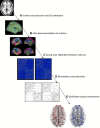Abnormalities in structural covariance of cortical gyrification in schizophrenia
- PMID: 24771247
- PMCID: PMC4481329
- DOI: 10.1007/s00429-014-0772-2
Abnormalities in structural covariance of cortical gyrification in schizophrenia
Abstract
The highly convoluted shape of the adult human brain results from several well-coordinated maturational events that start from embryonic development and extend through the adult life span. Disturbances in these maturational events can result in various neurological and psychiatric disorders, resulting in abnormal patterns of morphological relationship among cortical structures (structural covariance). Structural covariance can be studied using graph theory-based approaches that evaluate topological properties of brain networks. Covariance-based graph metrics allow cross-sectional study of coordinated maturational relationship among brain regions. Disrupted gyrification of focal brain regions is a consistent feature of schizophrenia. However, it is unclear if these localized disturbances result from a failure of coordinated development of brain regions in schizophrenia. We studied the structural covariance of gyrification in a sample of 41 patients with schizophrenia and 40 healthy controls by constructing gyrification-based networks using a 3-dimensional index. We found that several key regions including anterior insula and dorsolateral prefrontal cortex show increased segregation in schizophrenia, alongside reduced segregation in somato-sensory and occipital regions. Patients also showed a lack of prominence of the distributed covariance (hubness) of cingulate cortex. The abnormal segregated folding pattern in the right peri-sylvian regions (insula and fronto-temporal cortex) was associated with greater severity of illness. The study of structural covariance in cortical folding supports the presence of subtle deviation in the coordinated development of cortical convolutions in schizophrenia. The heterogeneity in the severity of schizophrenia could be explained in part by aberrant trajectories of neurodevelopment.
Figures



References
-
- Ammons RB, Ammons CH. The Quick Test (QT): provisional manual. Psychol Rep. 1962;11:111–161.
Publication types
MeSH terms
Grants and funding
LinkOut - more resources
Full Text Sources
Other Literature Sources
Medical

